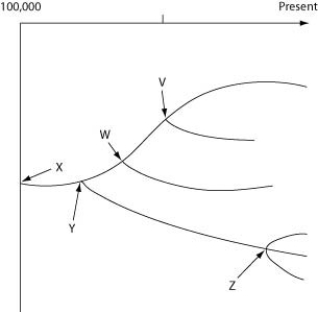The following questions refer to the evolutionary tree in the figure below.
The horizontal axis of the cladogram depicted below is a timeline that extends from 100,000 years ago to the present; the vertical axis represents nothing in particular. The labeled branch points on the tree (V-Z) represent various common ancestors. Let's say that only since 50,000 years ago has there been enough variation between the lineages depicted here to separate them into distinct species, and only the tips of the lineages on this tree represent distinct species.

-About thirteen different species of finches inhabit the Galápagos Islands today, all descendants of a common ancestor from the South American mainland that arrived a few million years ago. Genetically, there are four distinct lineages, but the thirteen species are currently classified among three genera. The first lineage to diverge from the ancestral lineage was the warbler finch (genus Certhidea) . Next to diverge was the vegetarian finch (genus Camarhynchus) , followed by five tree finch species (also in genus Camarhynchus) and six ground finch species (genus Geospiza) . If the six ground finch species have evolved most recently, then which of these is the most logical prediction?
A) They should be limited to the six islands that most recently emerged from the sea.
B) Their genomes should be more similar to each other than are the genomes of the five tree finch species.
C) They should share fewer anatomical homologies with each other than they share with the tree finches.
D) The chances of hybridization between two ground finch species should be less than the chances of hybridization between two tree finch species.
Correct Answer:
Verified
Q41: It has been observed that organisms on
Q42: Which of the following evidence most strongly
Q43: Which of the following observations helped Darwin
Q44: The following questions refer to the evolutionary
Q45: The questions below refer to the following
Q47: Pseudogenes are _.
A) composed of RNA, rather
Q48: The following questions refer to the evolutionary
Q49: The questions below refer to the following
Q50: What must be true of any organ
Q50: DNA sequences in many human genes are
Unlock this Answer For Free Now!
View this answer and more for free by performing one of the following actions

Scan the QR code to install the App and get 2 free unlocks

Unlock quizzes for free by uploading documents